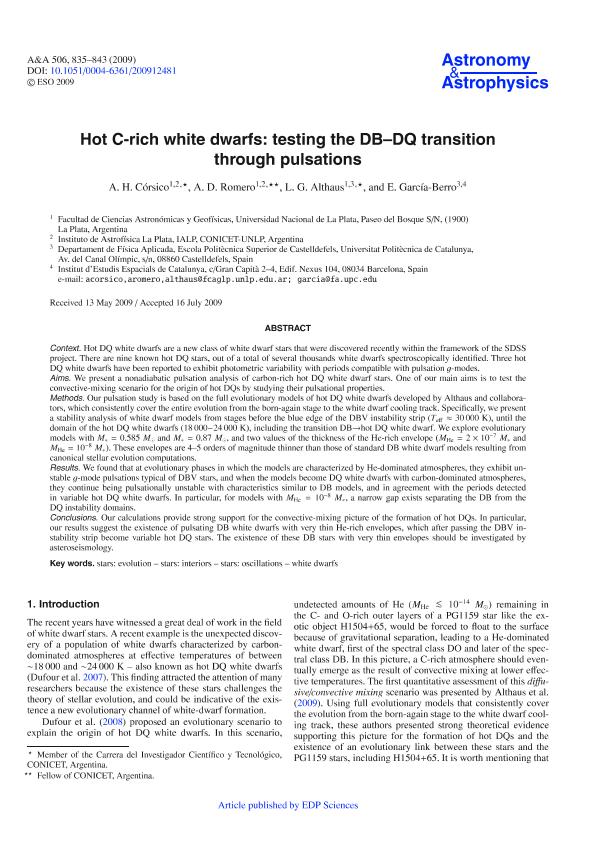Artículo
Hot C-rich white dwarfs: testing the transition DB-DQ through pulsations
Corsico, Alejandro Hugo ; Romero, Alejandra Daniela
; Romero, Alejandra Daniela ; Althaus, Leandro Gabriel
; Althaus, Leandro Gabriel ; García Berro, Enrique
; García Berro, Enrique
 ; Romero, Alejandra Daniela
; Romero, Alejandra Daniela ; Althaus, Leandro Gabriel
; Althaus, Leandro Gabriel ; García Berro, Enrique
; García Berro, Enrique
Fecha de publicación:
07/2009
Editorial:
EDP Sciences
Revista:
Astronomy and Astrophysics
ISSN:
0004-6361
Idioma:
Inglés
Tipo de recurso:
Artículo publicado
Clasificación temática:
Resumen
Context. Hot DQ white dwarfs are a new class of white dwarf stars that were discovered recently within the framework of the SDSS project. There are nine known hot DQ stars, out of a total of several thousands white dwarfs spectroscopically identified. Three hot DQ white dwarfs have been reported to exhibit photometric variability with periods compatible with pulsation g-modes. Aims. We present a nonadiabatic pulsation analysis of carbon-rich hot DQ white dwarf stars. One of our main aims is to test the convective-mixing scenario for the origin of hot DQs by studying their pulsational properties. Methods. Our pulsation study is based on the full evolutionary models of hot DQ white dwarfs developed by Althaus and collaborators, which consistently cover the entire evolution from the born-again stage to the white dwarf cooling track. Specifically, we present a stability analysis of white dwarf models from stages before the blue edge of the DBV instability strip ( ≈ 30 000 K), until the domain of the hot DQ white dwarfs (18 000-24 000 K), including the transition DBhot DQ white dwarf. We explore evolutionary models with M* = 0.585 and M* = 0.87 , and two values of the thickness of the He-rich envelope ( = 210-7 M* and = 10-8 M*). These envelopes are 4–5 orders of magnitude thinner than those of standard DB white dwarf models resulting from canonical stellar evolution computations. Results. We found that at evolutionary phases in which the models are characterized by He-dominated atmospheres, they exhibit unstable g-mode pulsations typical of DBV stars, and when the models become DQ white dwarfs with carbon-dominated atmospheres, they continue being pulsationally unstable with characteristics similar to DB models, and in agreement with the periods detected in variable hot DQ white dwarfs. In particular, for models with = 10-8 M*, a narrow gap exists separating the DB from the DQ instability domains. Conclusions. Our calculations provide strong support for the convective-mixing picture of the formation of hot DQs. In particular, our results suggest the existence of pulsating DB white dwarfs with very thin He-rich envelopes, which after passing the DBV instability strip become variable hot DQ stars. The existence of these DB stars with very thin envelopes should be investigated by asteroseismology.
Palabras clave:
Evolution of Stars
,
Interior Stars
,
Oscillations
,
White Dwarfs
Archivos asociados
Licencia
Identificadores
Colecciones
Articulos(IALP)
Articulos de INST.DE ASTROFISICA LA PLATA
Articulos de INST.DE ASTROFISICA LA PLATA
Citación
Corsico, Alejandro Hugo; Romero, Alejandra Daniela; Althaus, Leandro Gabriel; García Berro, Enrique; Hot C-rich white dwarfs: testing the transition DB-DQ through pulsations; EDP Sciences; Astronomy and Astrophysics; 506; 7-2009; 835-843
Compartir
Altmétricas



